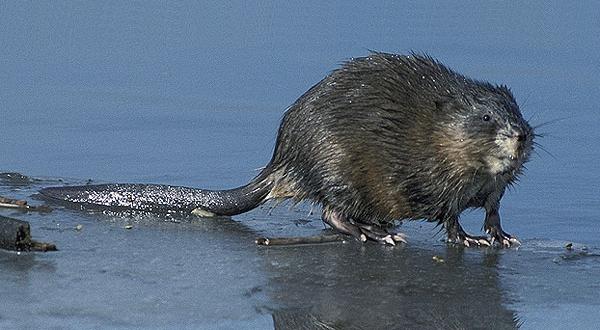Kingdom: Animalia
Phylum: Chordata
Class: Mammalia
Order: Rodentia
Superfamily: Muroidea
Family: Cricetidae
Subfamily: Arvicolinae
Tribe: Ondatrini
Genus: Ondatra
Species: Ondatra zibethicus
Natural habitat
It comes from Canada and North-America, it was settled to Europe next to Prague, it is valuable for its coat. It spred quickly in whole Europe and in the west part of Asia, it was forward by its migration in autumns and springs. The quickness of its spreading is explained by it hasn’t got natural competitor, it found free niche. It feeds similar like water vole and eurasian beaver, but they prefer food in other size. In these times it is looking for a new habitat. Primarily it lives in lakes or slow fluvial-rivers. It builds its nest from reed, dross and other plants, this can be one and a half meter wide and one meter high. One of the exits is under the water and the other one is on he riverside. It hides the entrance with tufts. Because of its favourite food (shell) mainly we can find it in lakes where these are situated. It consumes a lot of plants, it also likes cultivated plants so it is a frequenter ploughlands. It causes lots of damages which is not equal to its utility. That is the reason why in West-Europe people eradicate it somethimes with the help of the state. In despite of this, in Finland, Russia and North-China it is settled methodically because there its utility is bigger than the damages what it causes. The vole is wide-spread in our country too.
Morphology
It is the biggest vole race in the world. Its size can be 54-56cm and it weights almost 2kg. It’s distinguishable well from other small mammals in our country, it’s well above the similar rats and water voles. Its special peculiarities are its long, yellow nippers and its wide, flat head. The grinders of the older voles have root thats why we can easily determine their age. Its bodybuild comply with the lifestyle in the water, on its fingers are situated webs and bristle. Its back legs are much longer than fore legs, it uses them by swimming. It has got a long tail which is also useful in the water. The coat of the vole is bright maroon on its back and drab on its paunch, among the soft, short hair are long, bright tophair.
Reproduction
For three or four occasions it brings into the world 7-8 little voles. Its pregnancy keeps 23-27 days. The little ones are naked and blind, they open their eyes after 11 days and after 20 days they are already able to swim. After 3-4 weeks leave their mother because all of them need an individual territory. The name of the vole comes from that the jacks give off musksmell
Nutrition
The vole is herbivore but also consumes animals. It not only eats water-plants but it likes shells and snailes too and it causes damages in cultivated plants and ploughlands. It opens the shells with its tooth or it brings them on the riverside and waits until they open. It also consumes dead fishes.
Lifestyle
Except its two migrations the vole lives around its hollow. Voles live in small colony under the ground. It likes shallow water near the dams the thick reed. It’s active day and night buti t can’t see well in sunshine. It moves badly on the ground. It doesn’t hibernate during winters it just relaxes in its nest. In these times it eats reed and sedge which were collected in the summertime. Because of it hasn’t got competitors it’s well-observed around its hollow. If the vole is angry, it is a danger to people. It can be rabid and infected by leptospira (that is a bacteria). It causes damages by chewing barrages and dams. So it makes difficult agriculture, regulation of river, water management. It chews up the nets in the fish farms.
Enemies
In Europe it is threatened by few animals. In Europe lynx, fox, eagle, weasel and in North-America the american mink can be a danger to it. The vole is hunted for its coat and its harmful activities.
Role in the Ecosystem
It found a free niche in Europe that’s why it doesn’t cause any damages in the living world. In West-Europe it is a pest but its coat is also usuful there so a lot of colonies are situated there. Its lifestyle destroyes the ground of the riverside a bit. The big hollows can cause subsidence. The plants are collected by the voles are useful food for other soil-dwellings.
It isn’t endangered and it isn’t protected in Hungary.
Jermy Tibor és Balázs Klára (szerk.) A növényvédelmi állattan kézikönyve VI., Akadémiai Kiadó, 1988
Fazekas György – Szerényi Gábor: Biológia, Scolar Kiadó, 2009
http://fr.wikipedia.org/wiki/Rat_musqu%C3%A9
http://mek.niif.hu/03400/03408/html/572.html
http://hu.wikipedia.org/wiki/P%C3%A9zsmapocok#.C3.89letm.C3.B3dja
